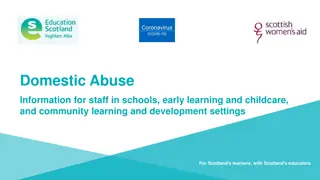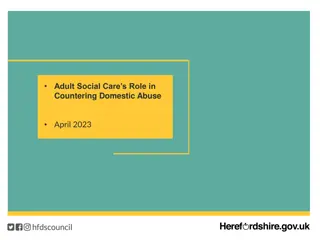Understanding Domestic Abuse During Covid-19
This briefing sheds light on the increased risk of domestic abuse during the Covid-19 pandemic, emphasizing how social distancing and self-isolation measures can exacerbate the danger for victims. It covers the definition and types of domestic abuse, the effects on different individuals, coercive control, signs and symptoms, as well as best practices for responding and providing support. The content explores why those at risk might become more invisible during isolation, the impacts on mental health for both victims and perpetrators, and the strain on critical services. It also offers practical advice on recognizing and addressing domestic abuse, advocating for open communication and vigilance within communities.
Download Presentation

Please find below an Image/Link to download the presentation.
The content on the website is provided AS IS for your information and personal use only. It may not be sold, licensed, or shared on other websites without obtaining consent from the author. Download presentation by click this link. If you encounter any issues during the download, it is possible that the publisher has removed the file from their server.
E N D
Presentation Transcript
7 Minute Briefing Domestic Abuse
This briefing covers. This briefing covers . The increased risk around domestic abuse during the Covid-19 outbreak Click to edit Master title style Definition and types of domestic abuse Who is affected by domestic abuse Coercive control and stalking Signs and symptoms Good practice Responding, signposting and support
Increased risk Covid-19 Domestic abuse has always been a hidden crime that takes place behind closed doors Click to edit Master title style Whilst the nation is being instructed to comply with social distancing and self-isolation, it is important to recognise that these understandable measures may mean that the risk of harm (both in frequency and severity) for those experiencing, or at risk of experiencing domestic abuse may actually increase
Why? Self-isolation, more home working and additional childcare responsibilities have the potential to make those at risk more invisible with less chance to seek help/disclose if abuse is happening. Home Click to edit Master title style for these families is not a place of safety, but a place where they will face a potential increase in violence and psychological abuse as well as even greater isolation Most children will not be attending school so there is less opportunity for staff and partners to pick up on issues
Why? continued. The mental health of both victims and perpetrators could be significantly and adversely affected Lack of social and sporting events may increase Click to edit Master title style frustrations within the home Worries about finance and day to day living are likely to become more evident which could increase risk Increased issues over child contact Critical services such as NHS, Police and Social Care will continue to be pressurised over the coming weeks
What can I do? Complete this briefing so that you are familiar with the types of domestic abuse and know how to signpost/refer someone into specialist support Click to edit Master title style services Keep communication channels open with vulnerable people and households Speak (remotely) to your friend, neighbours, colleagues, staff and teams so that we can be the eyes and ears within our communities. Even more so, during this period!
The Home Office (as of 2013) defines domestic abuse as: Any incident or pattern of Click to edit Master title style incidents of controlling, coercive or threatening behaviour, violence or abuse between those aged 16 or over who are or have been intimate partners or family members regardless of gender or sexuality.
What this means in reality : Coercive and controlling behaviour Psychological and emotional abuse Physical abuse Click to edit Master title style Sexual abuse Economic abuse Honour based abuse Female Genital Mutilation Forced Marriage See notes for examples of these
Who? Domestic abuse can affect anyone, although women are disproportionately affected (and research suggests that they are more likely to suffer more serious injury and ongoing assaults than men). Other more hidden victims .. teen violence Click to edit Master title style
Children Domestic violence can impact on children immensely. Statistics show that: 62% of children exposed to domestic abuse were directly harmed (physical/emotional abuse & neglect) Click to edit Master title style 52% had behavioural problems 39% had difficulties at school 60% felt they were to blame 25% exhibited abusive behaviour towards victim and siblings
Coercive Control Isolating a person from their friends and family Controlling what they do, where they go, who they can see, what they wear and when they sleep Click to edit Master title style Repeatedly putting them down, such as telling them they are worthless Enforcing rules and activity which humiliate, degrade or dehumanise the victim Financial abuse Threats to reveal or publish private information controlling social media
Stalking Pattern of fixated and obsessive behaviour Repeated, persistent, intrusive Click to edit Master title style Causes fear of violence and/or causes alarm and distress Sending gifts, making unwanted or malicious communication; damaging property, physical and sexual assault Stalking and coercive control are often correlated and can be a high risk indicator of harm
Signs and symptoms Injuries and excuses Low self esteem and personality changes Fear of conflict Self blame Click to edit Master title style Isolation and control Stress related problems Property damage Appointments: missed, frequently rescheduled, partner accompanies Mental distress Partner s behaviour: aggressive, overly dominant, doesn t let partner speak for themselves
Good practice Don t be scared to ask questions and be curious if it is safe to do so. This is important because: it can show the person you care and want to support them Click to edit Master title style the person you re talking to may not appear to be a typical victim it allows opportunity for disclosure it helps to build up a bigger picture of what s happening so you can think about risk; their sense of danger and how safe they feel
However, you must consider that Click to edit Master title style the perpetrator may be in the same room (or able to overhear) and/or the children might be present Always ask: Is it ok for you to talk?
If the response is: No accept this and tell the person you will ring back or they can ring you when it is more convenient. Record that this has happened and follow up with your line manager Click to edit Master title style and/or specialist support services if needed Yes - See useful prompts/questions on the next slide but remain mindful that the person may quickly hang up or sound different if the situation changes. If you suspect the person is in the room, it can be safer to ask questions/end the call by only asking questions that require a yes/no answer
Does your partner ever frighten you? Do you spend a lot of time trying to keep your partner happy? What happens when your partner is angry? Has someone else ever frightened or hurt you or your children? Do you ever have sex with your partner even if you Click to edit Master title style don t feel like it? Has anyone ever hurt you? Who? Does your partner make it difficult for you to come to attend work or other appointments? How do you cope with your partner s anger? Where do you go when you are frightened? Is there anyone you can talk to when you are frightened or upset?
EMERGENCY RESPONSE WEST YORKHIRE POLICE Call 999 (101 for anything else) CONCERNS ABOUT A CHILD Click to edit Master title style Kirklees Children s Services: call 01484 414960 (24 hours - professionals). Members of the Public: 01484 456848 (Mon-Fri 9:00am-5:00pm) CONCERNS FOR A VULNERABLE ADULT Kirklees Gateway to Care: call 01484 456848 (this also diverts to Emergency Duty outside office hours)
Signposting and support available Pennine Domestic Abuse Partnership 0800 0527222 (24 hour helpline) Women Centre (Kirklees and Calderdale) 01484 450866 Freephone National Domestic Abuse Helpline, run by Refuge Click to edit Master title style 0808 200 0247 www.nationaldahelpline.org.uk Galop (for lesbian, gay, bisexual and transgender people) 0800 999 5428 www.galop.org.uk Men s Advice Line 0808 801 0327 www.mensadviceline.org.uk Rape Crisis (England and Wales) 0808 802 9999 www.rapecrisis.org.uk
Coronavirus Help and Support: Click to edit Master title style https://www.kirklees.gov.uk/beta/h ealth-and-well- being/coronavirus.aspx























